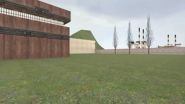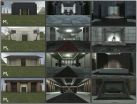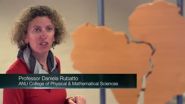(Press-News.org) VIDEO:
The brain has a complex system for keeping track of which direction you are facing as you move about; remembering how to get from one place to another would otherwise...
Click here for more information.
The brain has a complex system for keeping track of which direction you are facing as you move about; remembering how to get from one place to another would otherwise be impossible. Researchers from the University of Pennsylvania have now shown how the brain anchors this mental compass.
Their findings provide a neurological basis for something that psychologists have long observed about navigational behavior: people use geometrical relationships to orient themselves.
The research, which is related to the work that won this year's Nobel Prize in Physiology or Medicine, adds new dimensions to our understanding of spatial memory and how it helps us to build memories of events.
The study was led by Russell Epstein, a professor of psychology in Penn's School of Arts & Sciences, and Steven Marchette, a postdoctoral fellow in Epstein's lab. Also contributing to the study were lab members Lindsay Vass, a graduate student, and Jack Ryan, a research specialist.
It was published in Nature Neuroscience.
"Imagine coming out of a subway stop," said Marchette. "You know exactly where you are in the world, but you still have the experience of looking around to figure out which way you are facing. You might think, 'I'm looking at city hall, so I must be facing east.' It takes a second before it clicks.
"We're interested in how people are able to reset their sense of direction in the world and what cues they rely upon in the environment to do that."
To test how the brain makes these inferences, the researchers designed an experiment in which they introduced participants to a virtual environment, a set of four museums in a park, and had the participants memorize the location of the everyday objects on display in those museums. They then scanned their brains while asking them to recall the spatial relationships between those objects, such as whether the bicycle was to the left or the right of the cake.
In the scans, using a technique that measures blood flow to different regions of the brain known as fMRI, the researchers focused on a region known as the retrosplenial complex. People who have severe injuries to this region are able to recognize landmarks in their environments but are unable to recall how to get from one to another, suggesting that it plays a specific role in the type of memory used in navigation and orientation.
"The retrosplenial complex is very much underexplored," Epstein said. "While we don't have the ability to go in and look at individual neurons, like O'Keefe and the Mosers did in their Nobel Prize-winning work, one of the nice things about fMRI is that we didn't have to decide beforehand which areas of the brain to record from."
There are three ways the retrosplenial complex could conceivably encode this type of information and serve as part of a mental compass.
One way would be a "global" system, in which the brain tracks the absolute direction one is facing regardless of visual cues in the environment. In fact, there is good evidence that such a system exists in the brain, but the Penn team doubted that the retrosplenial complex was the central component of it.
An "idiosyncratic" system, in which the brain keeps tracks of direction for each environment independently, was another possibility. In such a system, remembering that your desk is on the north wall of your office would involve recalling the room itself and picking out the relevant features.
Finally, they considered a "geometric" system that is based on more generalized relationships between features in an environment. There, remembering that your desk is on the north wall of your office would involve recalling the relationship between the desk and the door — say, the desk is on the left when I enter the room — without having to specifically recall the room itself.
The architecture of the team's virtual park was critical for being able to distinguish which of these three types of systems participants were using to orient themselves in regards to the objects.
The park's four museums were laid out in a cloverleaf pattern around a central plaza, which itself could only be approached from the south. Each museum had a single door, all of which faced the center of the plaza. Each museum was visually distinct but all were identical in layout: a single room containing eight unique objects, two on each wall. The objects were contained in niches, such that participants could only see them from straight ahead.
"We designed it this way so that it was clear to the participants that each museum's back wall pointed in one of the cardinal directions," said Marchette. "And by placing the objects in the niches, we ensured that they could only see them when they were looking due north, south, east or west."
After being allowed to freely roam around the virtual environment, participants were tested about the locations of the objects. They were asked to return to the lab a day or two later, where they were given the opportunity to refresh their memories about the layout of the objects before entering the MRI scanner. There, they were shown words representing a pair of objects that were found in one of the museums and asked whether the second object was to the left or the right of the first.
The researchers used half of a participant's responses to calibrate their measurement of that participant's retrosplenial complex and then compared the activation patterns they saw there to responses in that participant's other half.
"If the retrosplenial complex supported a global system," Marchette said, "then it shouldn't matter whether people are imagining facing the back wall or the left wall; if you're looking north in one museum and north in the other, the activation patterns should be similar. As we expected, that doesn't happen.
"Likewise, for an idiosyncratic system, we would expect that remembering the back walls of two different museums would produce dissimilar patterns, since you would be remembering the room itself. That doesn't happen either."
Instead, the patterns look similar when participants imagined looking at objects that have the same geometric relationship to the surrounding room, regardless of the "true" direction the participant was facing. For example, remembering objects on the back walls of two different museums produced similar activation patterns, even though the back wall is north in one museum and east in the other.
"We can even reconstruct the location the participant is remembering based on those similarities," Epstein said. "Once we know what we are looking for based on the first half of a participant's responses, we can estimate the location of a given view entirely from the fMRI data, and they are reasonably close to where the views actually are. That's a pretty cool result. It's as if we can read out a 'floor plan' of the museums from each person's brain. And because the museums are geometrically identical, the retrosplenial cortex uses the same 'floor plan' for all of them"
The team's research provides a more complete picture of what is happening in the brain when people navigate from one place to another.
"Psychologists have long surmised that geometry is important for this kind of memory," Epstein said, "but this is beginning to show the neurological basis for it. We hope this opens the door for a deeper look at this region of the brain."
INFORMATION:
The research was supported by the National Institutes of Health and the National Science Foundation.
Brain's compass relies on geometric relationships, say Penn Researchers
2014-10-16
ELSE PRESS RELEASES FROM THIS DATE:
How, when, and why industrial ecology is good for business
2014-10-16
Industrial ecology, a rapidly growing field focused on sustainable production and consumption, has contributed numerous important tools to modern environmental management — life cycle assessment; "industrial symbiosis," or the by-product exchange between neighboring facilities; "design for environment"; and the use of material flow analysis to track resource use in supply chains, companies, and economies.
A new special feature of Yale's Journal of Industrial Ecology, titled "Industrial Ecology as a Source of Competitive Advantage," presents new research on how, ...
Study shows inpatient palliative care reduces hospital costs and readmissions
2014-10-16
New Rochelle, NY, October 15, 2014—Palliative care provided in the hospital offers known clinical benefits, and a new study shows that inpatient palliative care can also significantly lower the cost of hospitalization and the rate of readmissions. Further, the study shows the hospital can get the expertise it needs through a collaborative relationship with a community hospice. The results of a comparative study are published in Journal of Palliative Medicine, a peer-reviewed journal from Mary Ann Liebert, Inc., publishers. The article is available free on the Journal ...
Novel RNAi-based therapy for anemia stimulates liver to produce EPO
2014-10-16
New Rochelle, NY, October 16, 2014—To treat the debilitating anemia associated with reduced erythropoietin (EPO) production by the kidneys in chronic renal disease, patients are often given recombinant human EPO to increase hemoglobin levels. But that treatment has risks. A new approach that uses a small interfering RNA (siRNA) drug to stimulate natural EPO production by the liver has shown promising results in nonhuman primates, as reported in Nucleic Acid Therapeutics, a peer-reviewed journal from Mary Ann Liebert, Inc. publishers. The article is available free ...
Public health in the 21st century
2014-10-16
Ann Arbor, MI, October 16, 2014 – Although disease outbreaks and epidemics drawing worldwide attention emphasize the importance and acute need for public health professionals, the world faces a longer-term challenge—a public health workforce that is truly effective in the 21st century. In a new supplement to the American Journal of Preventive Medicine, experts address critical challenges to public health, from workforce development, capacity building, partnership and collaborations, and changes and needs in workforce composition.
As the U.S. healthcare system ...
New test can help doctors choose best treatment for ovarian cancer
2014-10-16
Researchers have devised a new test to help doctors diagnose ovarian tumours and choose the most appropriate treatment.
Successful treatment depends in part on accurately identifying the type of tumour, but this can be difficult. As a result, many women with cancer are not sent to the right specialist surgeon, or those with a benign cyst may have a more serious operation than they need.
In a study published today in the British Medical Journal, an international team led by Imperial College London and KU Leuven, Belgium describe a new test, called ADNEX, which can discriminate ...
Slow and steady does not win the weight loss race
2014-10-16
Led by Joseph Proietto, Sir Edward Dunlop Professor of Medicine at the University of Melbourne and Head of the Weight Control Clinic at Austin Health, the study also found that substantial weight loss is more likely to be achieved if undertaken rapidly.
"This randomised study highlights the urgent need for committees that develop clinical guidelines for the management of obesity to change their advice," he said.
The trial included 200 obese adults (BMI 30–45kg/m²) who were randomly assigned to either a 12-week rapid weight loss programme (average weight ...
Cryptic clues drive new theory of bowel cancer development
2014-10-16
Melbourne researchers have challenged conventional thinking on how the bowel lining develops and, in the process, suggested a new mechanism for how bowel cancer starts.
The researchers produced evidence that stem cells are responsible for maintaining and regenerating the 'crypts' that are a feature of the bowel lining, and believe these stem cells are involved in bowel cancer development, a controversial finding as scientists are still divided on the stem cells' existence.
Using 3D imaging technologies, Dr Chin Wee Tan and Professor Tony Burgess from the Walter and ...
Magnetic mirrors enable new technologies by reflecting light in uncanny ways
2014-10-16
WASHINGTON, Oct. 16—As in Alice's journey through the looking-glass to Wonderland, mirrors in the real world can sometimes behave in surprising and unexpected ways, including a new class of mirror that works like no other.
As reported today in The Optical Society's (OSA) new high-impact journal Optica, scientists have demonstrated, for the first time, a new type of mirror that forgoes a familiar shiny metallic surface and instead reflects infrared light by using an unusual magnetic property of a non-metallic metamaterial.
By placing nanoscale antennas at or ...
Scientists find ancient mountains that fed early life
2014-10-16
VIDEO:
Scientists from Australian National University reveal how they found a mountain range that fed an explosion of life 600 million years ago. The range stretched 2,500 km across Gondwana from...
Click here for more information.
Scientists have found evidence for a huge mountain range that sustained an explosion of life on Earth 600 million years ago.
The mountain range was similar in scale to the Himalayas and spanned at least 2,500 kilometres of modern west Africa and northeast ...
Plant communities produce greater yield than monocultures
2014-10-16
Although monocultures can be cultivated efficiently, they are anything but sustainable: environmental damage to soil and water caused by monoculture cultivation is becoming increasingly evident. Despite their disadvantages, however, monocultures remain the principal crop form and are regarded as the sole possibility of achieving higher yields in plant production – quite wrongfully, finds Bernhard Schmid, an ecology professor at the University of Zurich, who advocates a novel form of agriculture and forestry. After all, a new study carried out by PhD student Debra ...







